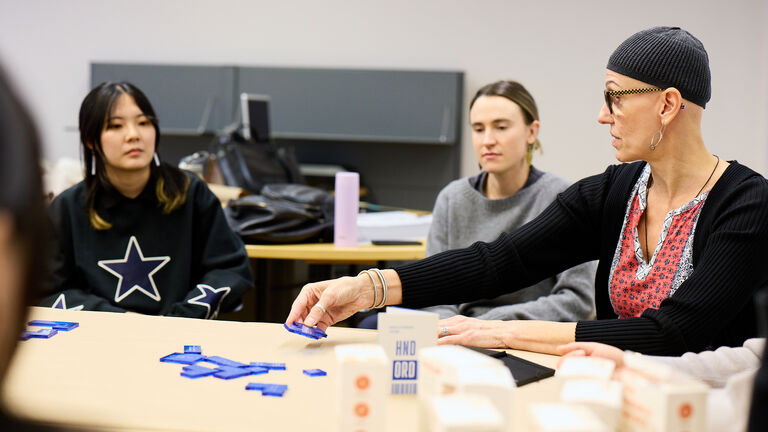
Tony Favarula
Graduate Overview
Visual Communication Design Graduate Overview
Application Deadline: January 10
Led by faculty who are actively engaged in design thinking and practice, Visual Communication Design students are challenged to think critically about what they create, take risks in their work, and experience the value and transformative ability of design.
Renowned Visual Communication Design faculty represent the diversity of contemporary design practice, research, and pedagogy with thriving practices both self-initiated and client-associated, physical and virtual, and individual and collaborative. Students are presented with a rich array of tools and ideas and work with faculty to broaden and deepen their understanding of the field, acquire new skills and approaches, and develop an innovative and mature body of work. Faculty guide students in self-initiated work that explores issues of personal interest and cultural/social significance.
Methodologies and Interdisciplinary Experimentation
Graduate students begin their coursework with critique seminars designed to encourage experimentation with new methodologies to further develop their individual work and exploration. Subsequent semesters are less structured—allowing students to work with individual advisors, generate individualized content, and experiment with other related disciplines—eventually culminating in fully realized theses. Students take part in advanced study of the history and interpretation of visual communication design through curricula that explore how the discipline has been influenced by, and in turn influences, cultural, social, political, industrial, and technological forces.
Design at the Intersection of Artistic Disciplines
Striking a balance between guidance and self-direction, the Visual Communication Design program offers both rigorous coursework and individualized attention in an open and interdisciplinary environment. Students are encouraged to explore other related departments at SAIC—Printmedia; Writing; Photography; Architecture, Interior Architecture, and Designed Objects; and Film, Video, New Media, and Animation—to extend their design work into new territories. Experiences with like-minded artists and designers working in various media allow students to make inventive, poetic, informative, expansive, and often unexpected connections in their own creative work.
MFA and Post-Baccalaureate Certificate Programs
Students are either admitted into the Master of Fine Arts (MFA) program, a two-year, 60-credit program, or the Post-Baccalaureate Certificate in Studio, a one-year, 30-credit program that can serve as a track into the MFA program. This path creates a three-year experience for students who often have little design experience and will benefit from additional education in preparation for continuation into the MFA program. The programs are highly competitive and bring together a talented group of students of diverse backgrounds, experiences, and research interests.
Graduate Projects
At the core of the MFA program are Graduate Projects. Taken every semester, Graduate Projects allow students to focus on their work in one-on-one meetings with a faculty member. In addition to meeting biweekly with a Visual Communication Design graduate faculty member, students may sign up for Graduate Projects with writers, artists, and academics from other departments at SAIC. Ultimately, it is the student’s work that drives the choice of advisor, and both disciplinary and interdisciplinary work is supported and advanced.
MFA Graduate Seminars
In the fall semester, several graduate seminar courses are offered. First-year MFA students are required to take a seminar. These courses explore a range of methodologies that lead to self-directed work and thesis development.
The primary issues these seminars address include: contemporary design practice, cultural and literary criticism, and cognitive, linguistic, structuralist, and other theories.
- MFA 5310 MFA Form-Configuration-Content
- MFA 5320 MFA Narrative A rchitectures
Critique Week
Critique Week, one of the principal means of assessment each semester, is a week-long schedule of critiques during which classes are suspended and the entire faculty and invited artists and designers assemble into panels that conduct intensive studio critiques with all studio and writing graduate students.
Fall semester critiques are organized by each department, with panels representing the discipline.
Spring semester critiques are interdisciplinary, with panel members of faculty, visiting artists, and peers from across SAIC departments. Interdisciplinary critiques in the spring semesters allow for a broader range of responses to the work, and are intended to assess the success of your work for a more general, yet highly informed, audience.
Studio critiques are required of every full-time graduate student pursuing an MFA in Studio or Writing degree. Typically, SAIC graduate students have at least four critique panels throughout their studies at SAIC, augmenting biweekly tutorials with their graduate advisors.
Interested in Learning More About the Program?
Continue to explore the SAIC Visual Communication Design department website to learn about our curricular offerings, faculty, students, and alumni, visit the Master of Fine Arts in Studio degree program for more detailed information, or schedule a tour.
Take the Next Step
Graduate Admissions Events
Learn how to prepare a competitive application, meet with faculty and staff, and explore our programs and facilities. LEARN MORE
MFA in Studio Admissions Information
Curriculum & Courses
Visit the graduate admissions website or contact the graduate admissions office at 312.629.6100, 800.232.7242 or gradmiss@saic.edu.
